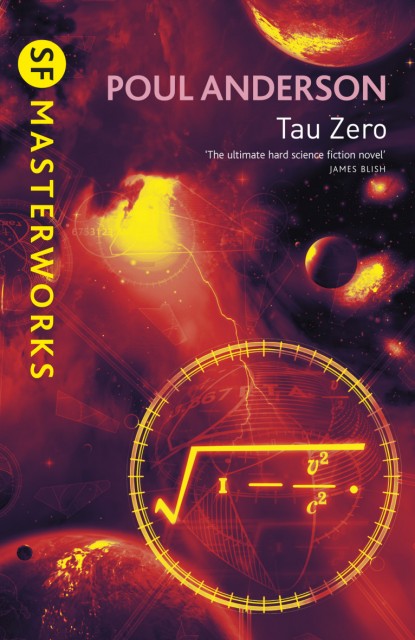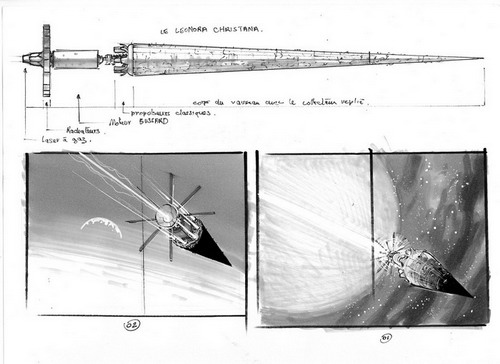Every once in a while I like to pick up SF classics that I have missed in my childhood. A while ago I compiled a list of my personal picks for essential SF novels, but I often find new books I would like to add to that list. Tau Zero by Poul Anderson is probably one of such classics which deserves to be read simply because of how influential it has been on modern science fiction.
To put it bluntly, Tau Zero is no more and no less than “Ram Scoop: The Novel”. That’s what it is about, and that’s it’s claim to fame. It is basically a few hundred page long geek out session on the topic of Busard Engines. Without it, Niven would probably never write his Known Space novels, Vinge would never embark on his Zones of Thought trilogy, Reynolds would never write House of Suns, and etc.. This book can be directly credited for making the term “ramjet” a permanent mainstay of science fiction parlance.
The plot is astonishingly simple: it is near future and humanity is slowly colonizing the galaxy using ramjets to ferry explorers to distant habitable planets. The crews travel awake, relying on the time dilation that occurs at relativistic speeds to make the trip manageable. On one such long distant jaunt something goes terribly wrong, and the deceleration subsystem stops working. The ship is unable to slow down, misses its target destination and keeps on accelerating, hurling towards the unknown while decades and then centuries pass in the outside world.
If you are a bit shaky on general relativity and don’t really grok the whole time dilation concept, don’t worry. Anderson explains it in excruciating detail. By the time you reach the final page, you will know just about anything there is to know about the physics of near light speed travel. That and you will posses almost an intimate level of knowledge about the internal workings of Busard Ramjets. To be frank, those parts of the book were actually rather fascinating and enjoyable. He waxes romantic about the properties of the Tau coefficient, the special relativity. He beautifully describes his pet ship hurling through space and spends many paragraphs musing about the Doppler shifted star-scape the crew can see from the view ports. All of that is great. The problems start when that pesky crew decides to do or talk about things other than science of space flight. Unfortunately, they do a lot of that.
The tricky part of the scenario Anderson came up with, is that the discussion of the human condition is almost unavoidable. The crew is trapped on a rogue spaceship that is unable to stop and is constantly accelerating and increasing the time dilation. They have to come to terms with the fact that even if they manage to somehow repair their engines, they may no longer have a planet to come back to because eons would have passed in the outside world. This, as you can imagine is a rather bitter pill to swallow for anyone. Anderson tries to describe the ways in which the space travelers may choose to cope with such a predicament.
Judging from the way Anderson describes interpersonal relationships and romantic engagements, one begins to suspect that he might have never actually observed real people interacting “in the wild”. His characters are violently uninteresting and insist on having abysmally boring, robotic conversations about their love lives whenever they are not busy telegraphing sadness and despair. You just know that Anderson’s heart is not in it though. He writes the human bits because he has to – there is a rule somewhere that your novel has to have human characters that readers need to be able to relate to. But it is painfully obvious that the one and only character he really cares about is Leonora Christine – the ship itself.
Its like: “Guys, guys, guys! Lenora just flew through a g-type main sequence star and annihilated an entire solar system, and the crew didn’t even notice. How awesome is tha… I mean, everyone was sad. And that one guy was upset because his girlfriend is cheering. And that other woman is depressed because like religion and stuff… Look, can we talk about how awesome it is that the ship just fucking punched through a star? Like seriously!”
I’m exaggerating, of course, but only a little bit. It’s not that his characters are boring because they talk about science. You can write really compelling characters that never talk about anything else. They are boring specifically because Anderson makes a herculean effort to have them talk about relationships, hopes, dreams and desires. But it never seems real or relocatable. Whenever he tries to wrap his words around a human emotion, he hits the uncanny valley big time.
Perhaps it is Anderson’s writing style. Is awkward, ponderous and hollow most of the time. His narrator’s voice is more suited to describing epic events in a detached, clinical manner than to conveying human feelings. The only brief flights of fancy happen when he talks about astronomy or science. That said, he is really good at explaining the physics and mathematics behind the ramjet function in very accessible and layman friendly way. So if you are into that sort of thing, you will enjoy bits and pieces of this novel. Just make sure you set your expectations low in terms of interpersonal drama and suspense. There isn’t any.
Still, it is a worthwhile read for the educational value alone. That and it is a classic that inspired many writers, and made the Busard ramjet to be one of science-fiction’s most beloved sub-light propulsion systems.

